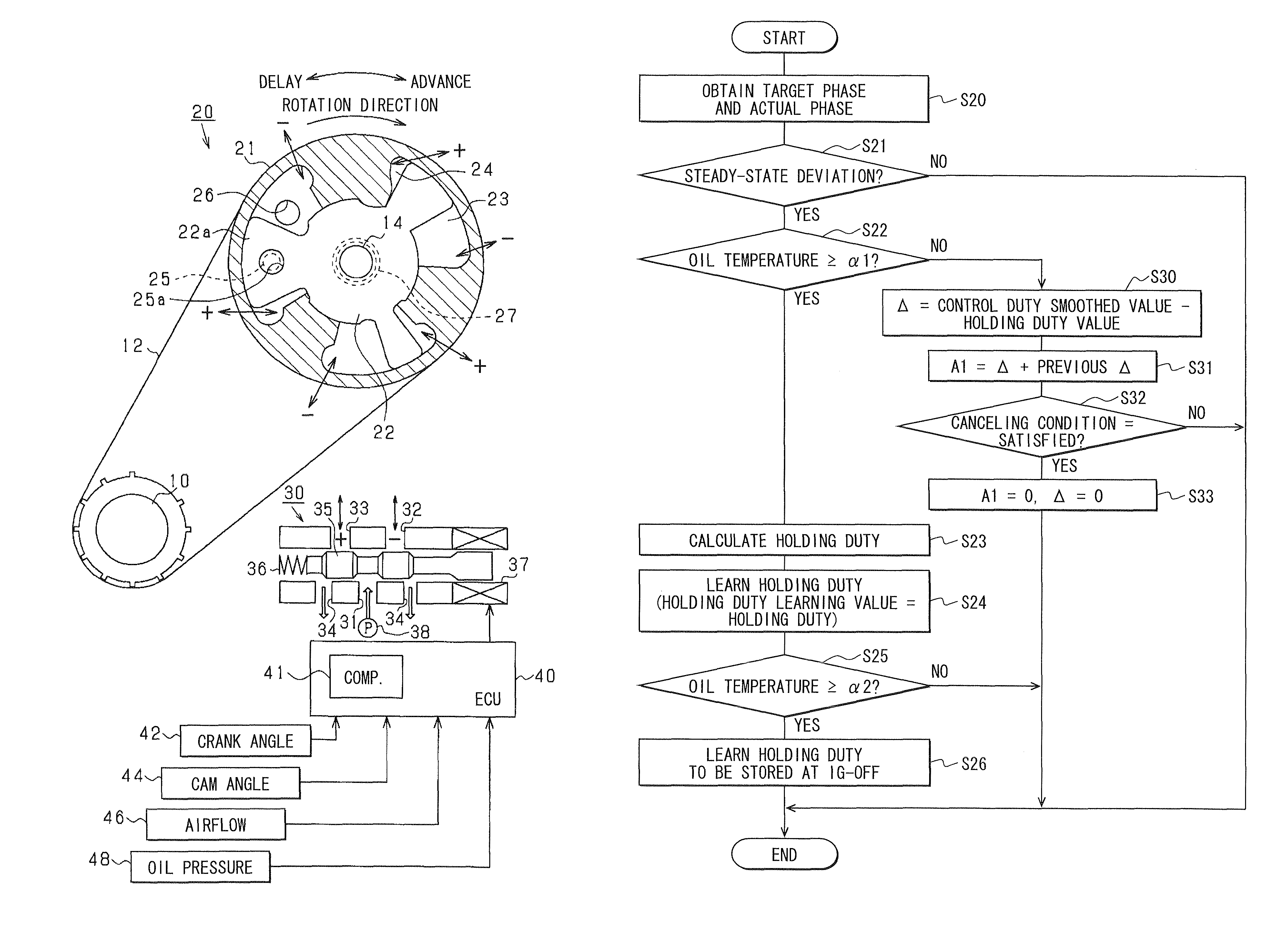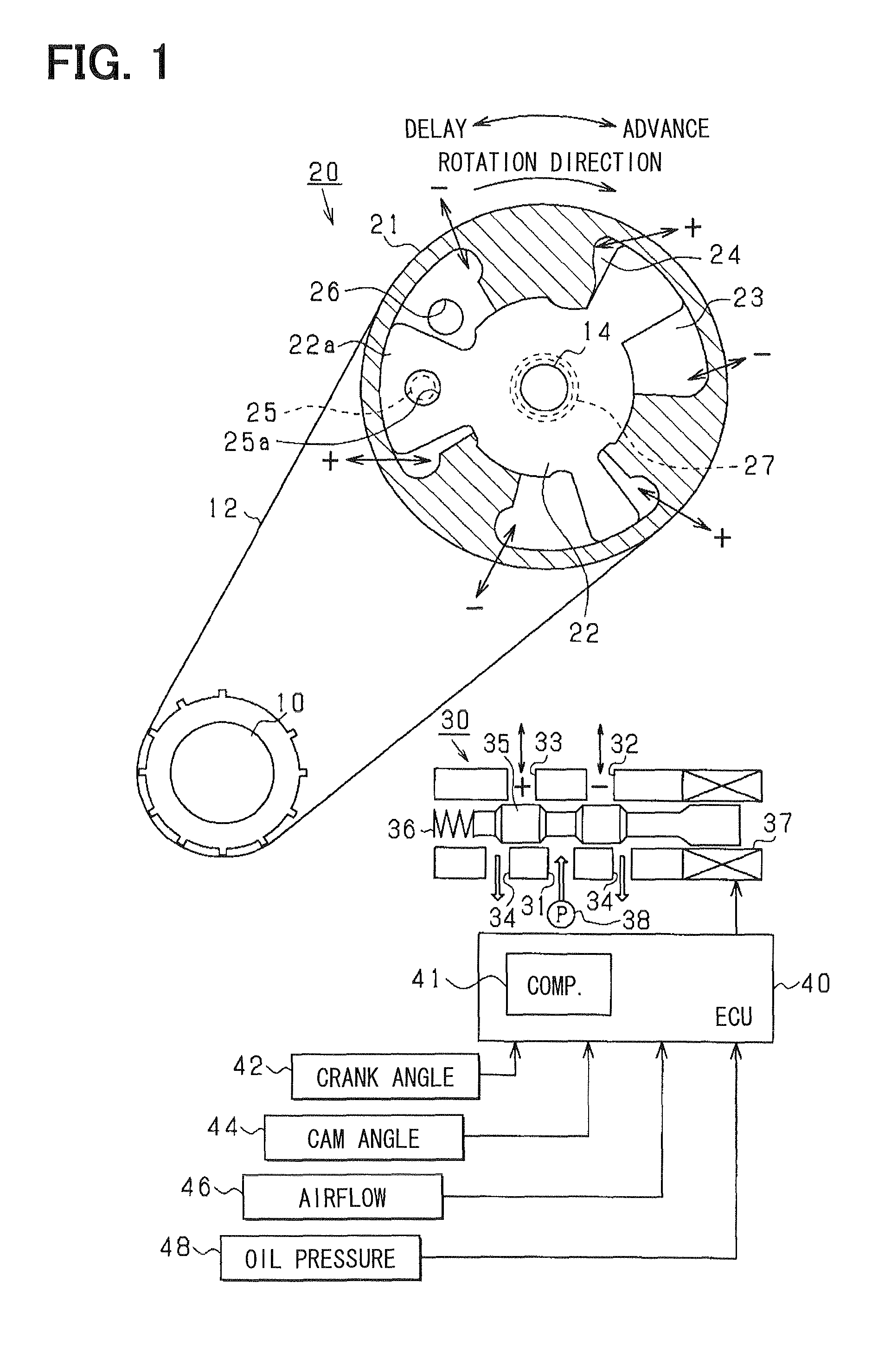Engine valve control device
a control device and engine valve technology, applied in electrical control, non-mechanical valves, couplings, etc., can solve the problems of excessive correction, inability to cancel steady-state deviation, slow response speed of actual phase with respect to change of target phase, etc., to improve controllability and controllability, e.g., quick reaction properties
- Summary
- Abstract
- Description
- Claims
- Application Information
AI Technical Summary
Benefits of technology
Problems solved by technology
Method used
Image
Examples
first embodiment
[0039]FIG. 1 shows an entire construction of an engine valve control mechanism according to a first embodiment of the present invention.
[0040]In FIG. 1, a power of a crankshaft 10 (output shaft) of an engine (internal combustion engine) is transmitted to a camshaft 14 via a belt 12 and a valve timing adjusting device 20 (referred to as VVT, hereafter). The VVT 20 has a first rotating body 21 (housing) mechanically linked with the crankshaft 10 and a second rotating body 22 (vane rotor) mechanically linked with the camshaft 14. In the present embodiment, the second rotating body 22 has multiple protrusions 22a (vanes) and is accommodated in the first rotating body 21. The protrusions 22a of the second rotating body 22 and an inner wall of the first rotating body 21 define delay chambers 23 and advance chambers 24. The delay chambers 23 delay a rotation angle (i.e., relative rotation phase) of the camshaft 14 relative to the crankshaft 10. The advance chambers 24 advance the relative ...
second embodiment
[0072]Next, a second embodiment of the present invention will be described.
[0073]In the above-described first embodiment, the control duty is calculated based on the holding duty learning value and the feedback correction values (proportional term duty and differential term duty). In the second embodiment, the control duty is calculated by taking into account a steady-state deviation correction value A1 explained below in addition to the holding duty learning value and the feedback correction values. Hereafter, processing contents according to the present embodiment shown in FIGS. 6 and 7 will be explained, focusing on differences from FIGS. 2 and 4.
[0074]First in S10 to S13 of FIG. 6, like the processing shown in FIG. 2, the actual phase and the target phase are obtained (S10), the deviation between the obtained phases is calculated (S11), and the feedback correction values are calculated based on the calculated deviation (S12). In following S13, the learning value of the holding d...
third embodiment
[0094]Next, a third embodiment of the present invention will be explained.
[0095]In the above-described second embodiment, the control duty is calculated based on the holding duty learning value, the feedback correction values (proportional term duty and differential term duty) and the steady-state deviation correction value A1. In the third embodiment, the control duty is calculated by taking into account an oil pressure correction value A2 and a phase correction value A3 explained below in addition to the holding duty learning value, the feedback correction values and the steady-state deviation correction value A1. Hereafter, processing contents according to the present embodiment shown in FIGS. 9 and 10 will be explained, focusing on differences from FIG. 6. In the present embodiment, processing similar to the processing of FIG. 7 of the second embodiment is performed in addition to the processing of FIGS. 9 and 10.
[0096]First in S10 to S13 and S131 of FIG. 9, like the processing ...
PUM
 Login to View More
Login to View More Abstract
Description
Claims
Application Information
 Login to View More
Login to View More - R&D
- Intellectual Property
- Life Sciences
- Materials
- Tech Scout
- Unparalleled Data Quality
- Higher Quality Content
- 60% Fewer Hallucinations
Browse by: Latest US Patents, China's latest patents, Technical Efficacy Thesaurus, Application Domain, Technology Topic, Popular Technical Reports.
© 2025 PatSnap. All rights reserved.Legal|Privacy policy|Modern Slavery Act Transparency Statement|Sitemap|About US| Contact US: help@patsnap.com



